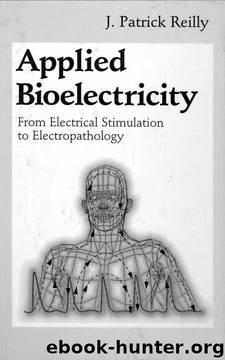Applied Bioelectricity: From Electrical Stimulation to Electropathology (Studies in British Literature; 37) by J. Patrick Reilly

Author:J. Patrick Reilly [Reilly, J. Patrick]
Language: eng
Format: epub
Published: 2008-06-12T05:32:00+00:00
8.3 Fundamental Principles of Skeletal Muscle Electrical Stimulation
Strength-D u ration (S-D) Relations for Neuromuscular Excitation
The most basic requirement for electrical stimulation of a skeletal muscle fiber is that an action potential(s) must be elicited on the a-motor neuron innervating the fiber or within the membrane of the muscle fiber itself. As has been discussed in Sect. 3.5, the electric excitability of myelinated nerve is generally much greater than that of skeletal muscle (see Parry, 1971; Walthard and Tchicaloff, 1971; Mortimer, 1981). Figure 8.2 depicts S-D curves (see Sect. 4.2) for transcutaneous stimulation of human skeletal muscles by regulated-voltage waveforms. We see that, in this example, direct electrical stimulation of denervated muscle requires substantially higher rheobase (i.e., the stimulus strength needed for large pulsewidths) and chronaxy (i.e., the stimulus pulsewidth at twice rheobase) values than for normal stimulation, where a-motor neuron axons can be activated.
Strength-duration curves for cat skeletal muscle stimulation with an implanted intramuscular electrode (see Sect. 8.4) and regulated-current monophasic stimuli are shown in Fig. 8.3. In these experiments on cat skeletal muscle (Mortimer, 1981), evoked isometric muscle response was held constant at a small fraction of total possible force. Once again, we see that the curve for direct muscle stimulation (in this case, following administration of the motor end-plate blocking-agent curare) shifts up and to the right in comparison to the curve for neural stimulation. Crago et al. (1974) conducted similar experiments on intramuscular stimulation of curarized and noncurarized cat skeletal muscle. They found that, over a range of stimulus pulse durations and amplitudes, direct (curarized) muscle stimulation accounted for only 3 to 7% of isometric muscle force evoked by neural (uncurarized) stimulation with identical parameters.
An S-D curve time constant r,. can be determined for both neural and direct muscle stimulation by performing a mathematical fit of experimental data to Lapicque's form of the S-D curve as expressed by Eq. (4.17). Such data indicate r, for denervated skeletal muscle of 4.3 to 57.6ms, and for intact muscle of 20 to 700µs (Oester and Licht, 1971). In that just- suprathreshold intact muscle stimulation is accomplished indirectly through excitation of a-motor neuron axons, we would expect that the S-D time constant values for intact muscle and large myelinated nerve stimulation would be similar. Indeed, for mammalian peripheral myelinated nerve fibers, experimentally obtained values from 29ps to over 800ps can be determined (Ranck, 1975, Li and Bak, 1976).
We have seen in Chapter 4 that r, is a property not just of the excitable membrane, but also of the method of excitation. In general, r,. becomes greater as the stimulus current crossing the cell membrane becomes more gradually distributed along the longitudinal dimension. The absolute minimum values of r,. for neural and direct muscle monophasic rectangular stimulation are the actual membrane time constants (r ) for u-motor neuron nodes of Ranvier and skeletal muscle sarcolemma.' Based on data obtained from rabbit peripheral myelinated axons by Chiu and colleagues (Chiu et al., 1979: Chiu and Ritchie, 1981), the author has estimated that node of Ranvier r.
Download
This site does not store any files on its server. We only index and link to content provided by other sites. Please contact the content providers to delete copyright contents if any and email us, we'll remove relevant links or contents immediately.
| Anatomy | Animals |
| Bacteriology | Biochemistry |
| Bioelectricity | Bioinformatics |
| Biology | Biophysics |
| Biotechnology | Botany |
| Ecology | Genetics |
| Paleontology | Plants |
| Taxonomic Classification | Zoology |
Sapiens: A Brief History of Humankind by Yuval Noah Harari(13979)
The Tidewater Tales by John Barth(12391)
Mastermind: How to Think Like Sherlock Holmes by Maria Konnikova(6932)
Do No Harm Stories of Life, Death and Brain Surgery by Henry Marsh(6683)
The Thirst by Nesbo Jo(6432)
Why We Sleep: Unlocking the Power of Sleep and Dreams by Matthew Walker(6347)
Life 3.0: Being Human in the Age of Artificial Intelligence by Tegmark Max(5182)
Sapiens by Yuval Noah Harari(5117)
The Longevity Diet by Valter Longo(4856)
The Body: A Guide for Occupants by Bill Bryson(4577)
The Rules Do Not Apply by Ariel Levy(4520)
The Immortal Life of Henrietta Lacks by Rebecca Skloot(4248)
Why We Sleep by Matthew Walker(4190)
Animal Frequency by Melissa Alvarez(4148)
Yoga Anatomy by Kaminoff Leslie(4100)
The Hacking of the American Mind by Robert H. Lustig(4080)
All Creatures Great and Small by James Herriot(3980)
Barron's AP Biology by Goldberg M.S. Deborah T(3941)
Double Down (Diary of a Wimpy Kid Book 11) by Jeff Kinney(3921)
